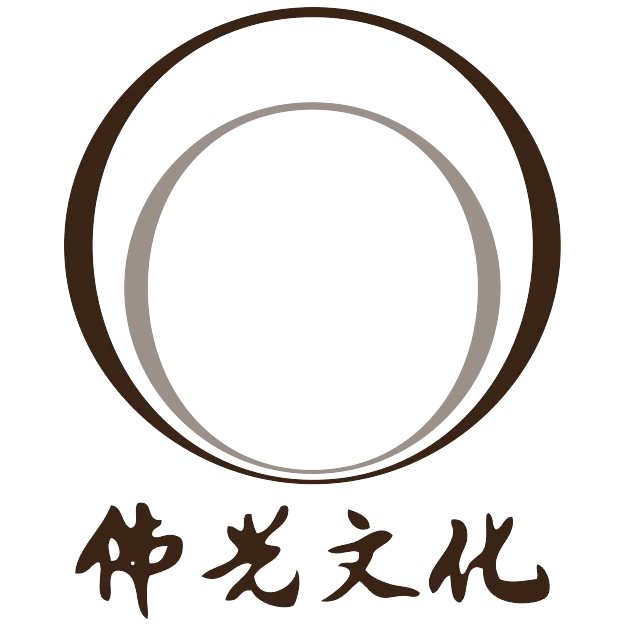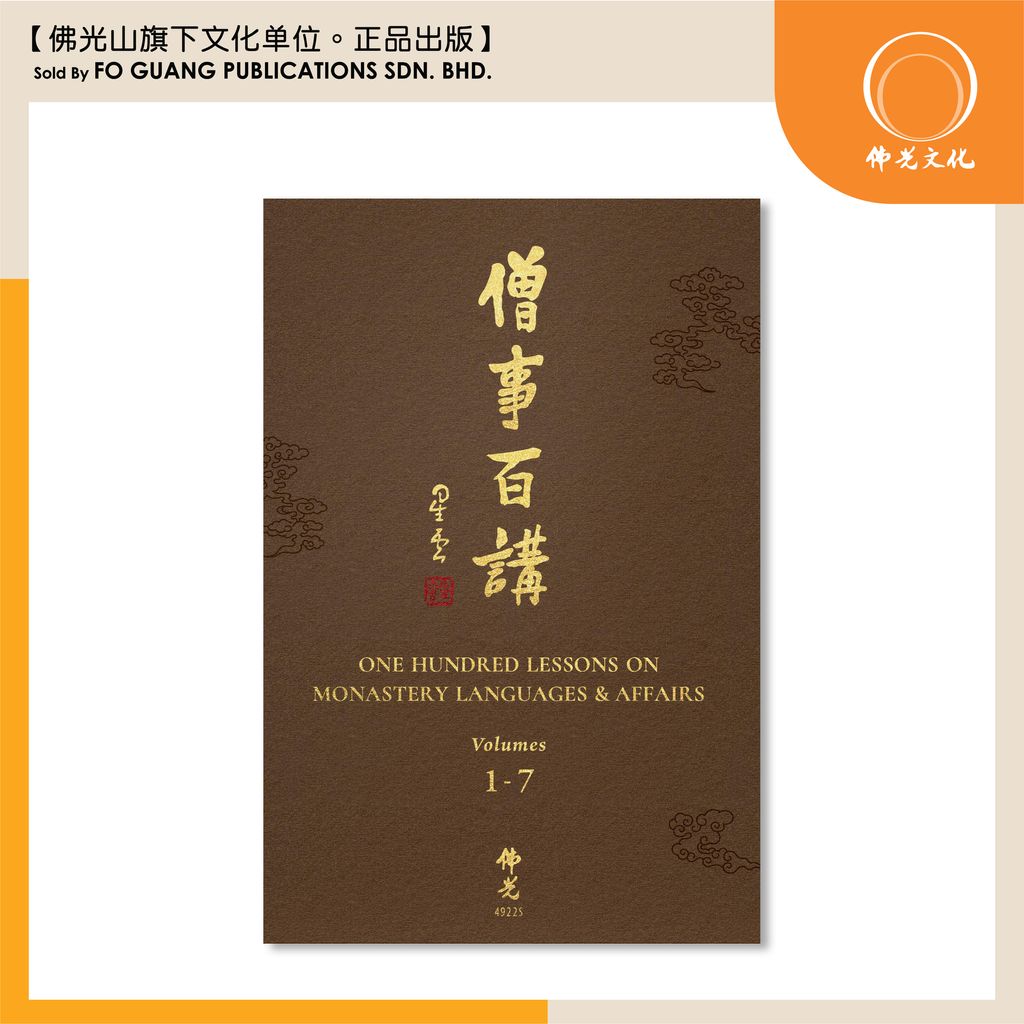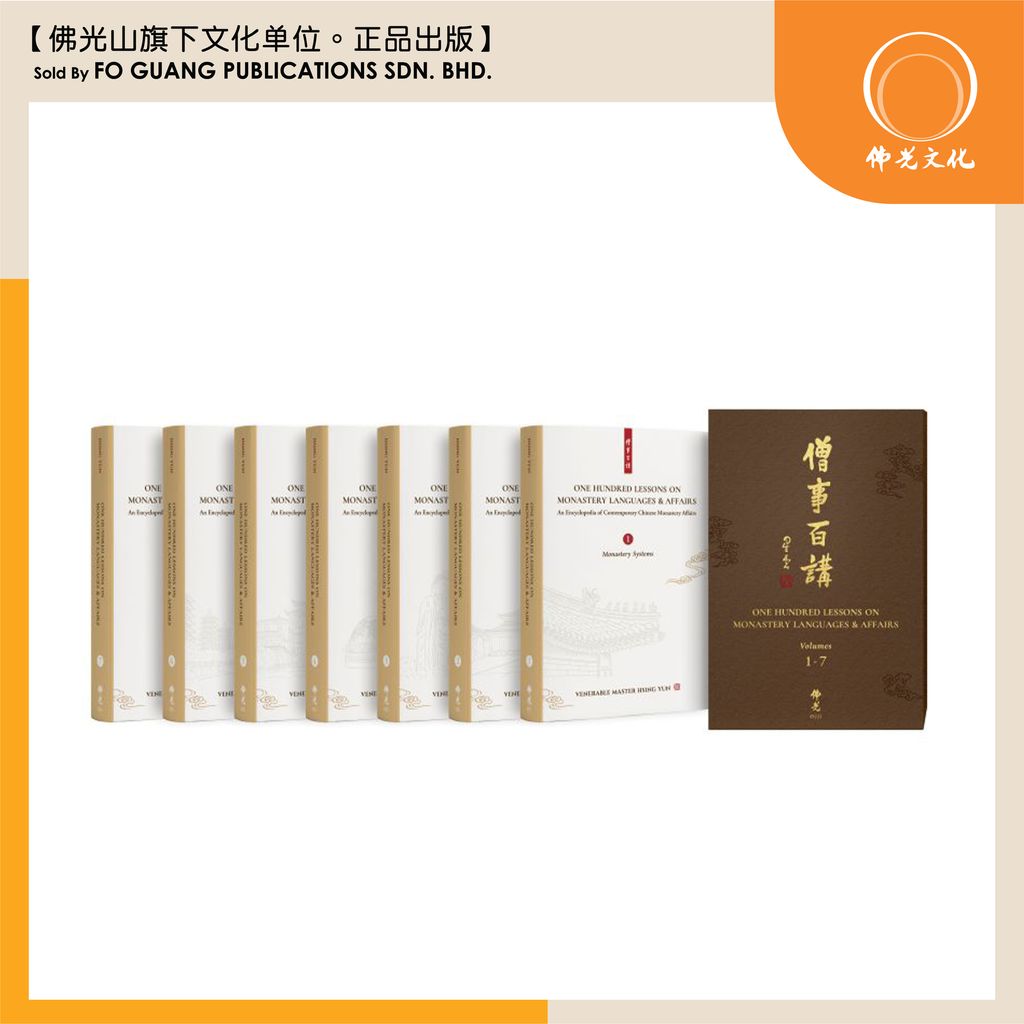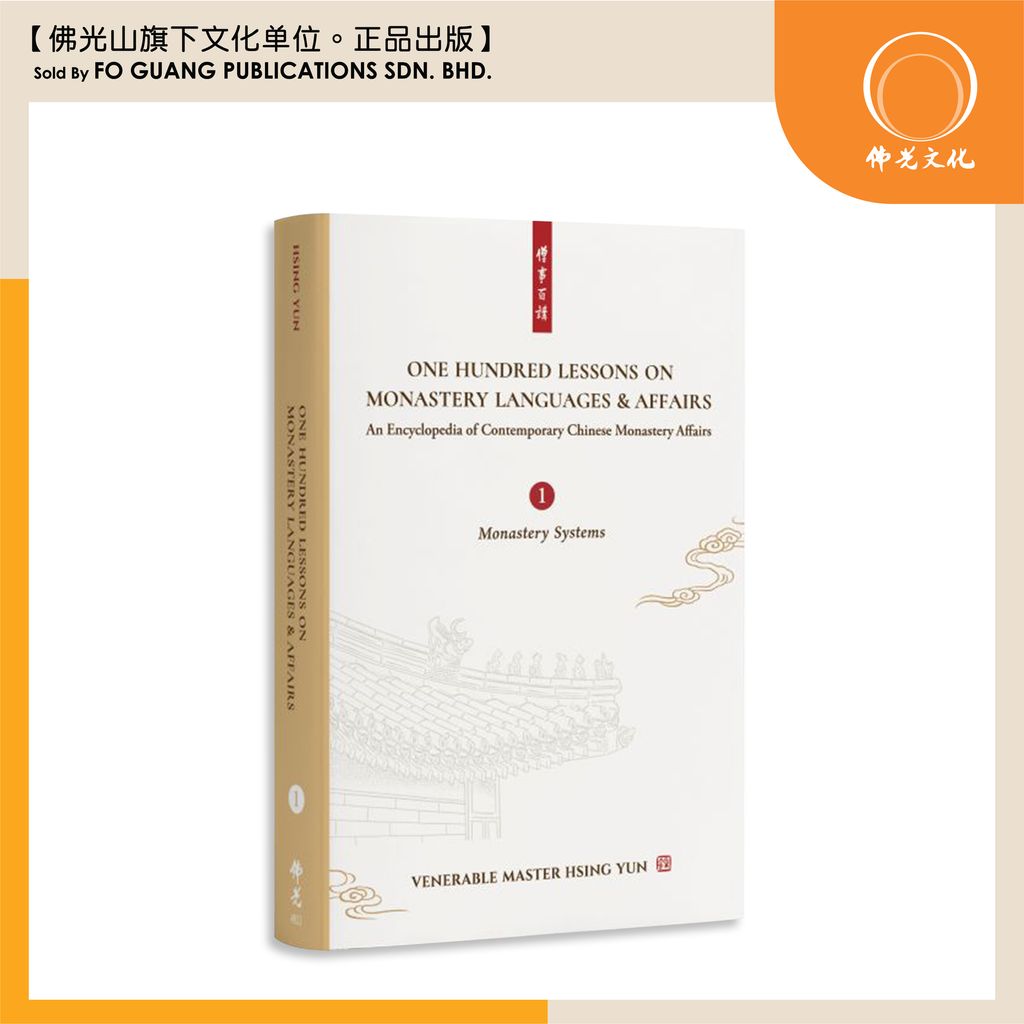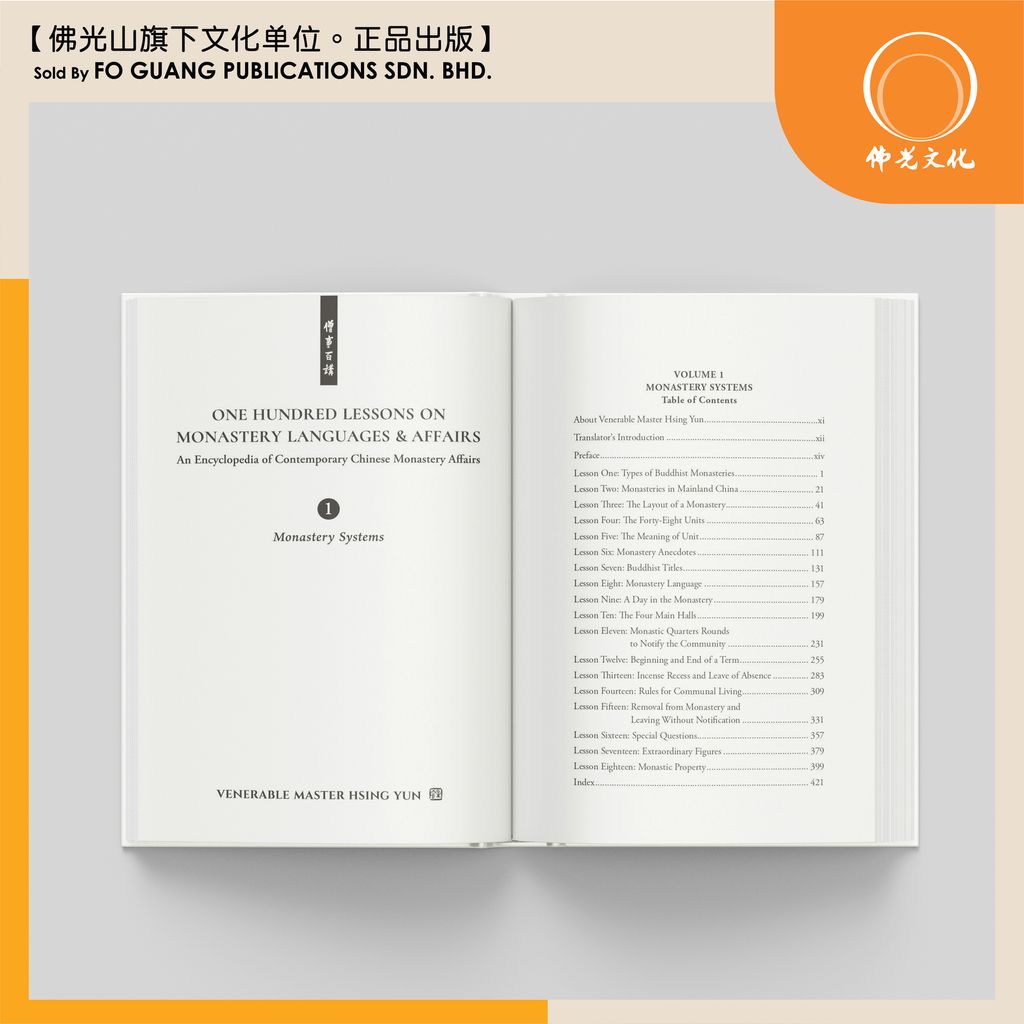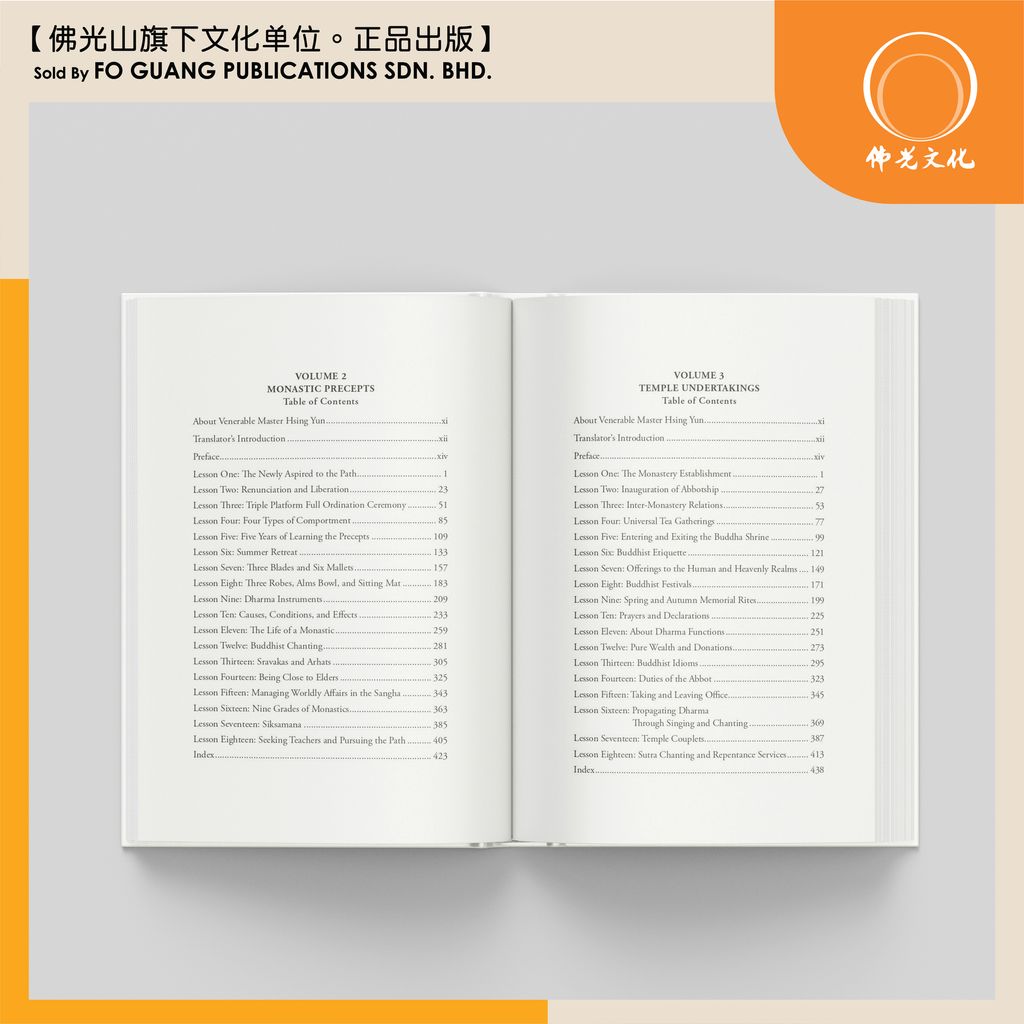佛光文化事业有限公司
[Pre-Order] (预购) One Hundred Lessons on Monastery Languages & Affairs 僧事百讲 (英文版套书)
- Regular price
- RM 420.00
- Sale price
- RM 420.00
- Regular price
-
RM 0.00
分享
书名:One Hundred Lessons on Monastery Languages & Affairs
作者: 星云大师
译者:Venerable Zhi Tong, Silver Tan
绘者:Madeleine Bianchi
编者:妙光法师Venerable Miao Guang
出版社:佛光文化事业有限公司
出版日期:2025-09-01
语言:繁体中文
ISBN:9789574578818
规格:软精装 / 14.8 x 21 cm / 普通级 / 黑白印刷/ 初版
出版地:台湾
重量:3.5kg
内容简介
- 全译103讲,保留问答模式
- 从第1册至第6册涵盖制度、戒法、行事、共修、组织、推展等六大面向
- 第7册〈词汇选〉收录3000+名相、150+用语诗偈,中英对照检索便利
- 名相附中文原文,易懂易查(例如: “Karmadāna” 维那)
- 澳、美、马等地区30位青年携手译撰及插画,体现集体创作与传承
The transmission of Buddhism to China gave rise to a uniquely rich and systematic monastic tradition. One Hundred Lessons on Monastery Languages & Affairs offers an in-depth exploration of this tradition through six themes: Monastery Systems, Monastic Precepts, Temple Undertakings, Cultivation and Gatherings, Organizational Management, and Spread of Buddhism. Drawing from decades of lived experience, it guides readers through the past, present, and evolving future of Chinese Buddhist monasticism.
作者介绍 | 作者简介
星云大师(Venerable Master Hsing Yun)
Venerable Master Hsing Yun was born in 1927 in Jiangdu, Jiangsu Province, China. At the age of 12, he was tonsured by Venerable Master Zhikai in Qixia Temple, Nanjing, with Dajue Temple in Yixing, Jiangsu, as his ancestral temple. He later became the 48th-generation lineage holder of the Linji Chan school. In 1947, he graduated from Jiaoshan Buddhist College, and also trained at various Chan, Pure Land, and Vinaya monasteries, including Jinshan, Qixia, and others. He received a comprehensive Buddhist education in the lineage, teachings, and Vinaya disciplines. Later on, the Venerable Master was invited to serve as the principal of Baita Elementary School, and also the editor-in-chief of Raging Billows Monthly.
In the spring of 1949, the Venerable Master arrived in Taiwan. He served as the editor-in-chief of Human Life Magazine, Buddhism Today Magazine, and Awakening the World.
In 1967, the Venerable Master founded the Fo Guang Shan Buddhist Order, with the Four Objectives: to propagate the Dharma through culture; to foster talents through education; to benefit society through charity, and to purify people’s minds through spiritual cultivation. Guided by the principles of Humanistic Buddhism, he went on to establish over three hundred temples worldwide. Additionally, he oversaw the creation of various art galleries, libraries, publishing companies, bookstores, the Merit Times newspaper, and the Cloud and Water Mobile Clinic. Furthermore, he established sixteen Buddhist colleges and founded three high schools and five universities, including the University of the West in the United States, Fo Guang University in Taiwan, Nanhua University in Taiwan, Nan Tien Institute in Australia, and Guang Ming College in the Philippines. Notably, he also established the Institute of Humanistic Buddhism.
In 1970, the Venerable Master established Da Ci Children’s Home and the Lanyang Ren Ai Senior Citizen’s Home, providing shelter and care for vulnerable young children, and elderly individuals. He also actively engaged in emergency relief efforts, contributing to the fostering of a welfare society. Then, in 1991, he founded the Buddha’s Light International Association (BLIA) and was elected as the President of the World Headquarters. Under his guidance, the association's mission expanded, symbolized by the saying, “the Buddha’s Light shining over three thousand realms, and the Dharma water flowing continuously through the five continents.”
In 1977, the Fo Guang Buddhist Canon, the Fo Guang Dictionary of Buddhism, and the 132-volume Selected Chinese Buddhist Texts in Modern Language were compiled. In 2017, the Complete Works of Venerable Master Hsing Yun was published, comprising 365 volumes with over 30 million words, systematically expounding the ideologies, teachings, theories, and practical outcomes of Humanistic Buddhism.
In 2023, the Venerable Master peacefully passed away, his virtuous deeds complete and fulfilled, having reached the age of ninety-seven. He was revered as the Founding Master of the Fo Guang Order, and he left behind this poignant poem:
A mind with the compassionate vow to deliver sentient beings,
A body like a boat on the Dharma ocean, unbound.
Should you ask what I have achieved in this lifetime?
Peace and happiness shine upon the five continents.
江苏江都人,一九二七年生,十二岁礼志开上人为师,祖庭江苏宜兴大觉寺,传临济正宗第四十八世。一九四七年于焦山佛学院毕业,期间曾参学金山、栖霞等禅净律学诸大丛林,历经宗下、教下、律下等完整的佛门教育。后应聘为白塔小学校长,主编《怒涛》月刊。
一九四九年春来台,主编《人生杂志》、《今日佛教》、《觉世》等佛教刊物。
一九六七年创建佛光山,树立「以文化弘扬佛法,以教育培养人才,以慈善福利社会,以共修净化人心」四大弘法宗旨,以「人间佛教」为宗风,先后在世界各地创建三百余所道场,创办多所美术馆、图书馆、出版社、书局、人间福报、云水医院,兴办佛教学院十六所,中学三所,及西来、南华、佛光、南天、光明五所大学,及人间佛教研究院。
一九七O年后,相继成立「大慈育幼院」、「仁爱之家」,收容抚育无依之幼童、老人及从事急难救济等福利社会。一九九一年成立「国际佛光会」,被推为总会会长,实践「佛光普照三千界,法水长流五大洲」的理想。
一九七七年编纂《佛光大藏经》、《佛光大辞典》,《中国佛教经典宝藏精选白话版》等。二O一七年出版《星云大师全集》,共三百六十五册,三千余万字,有系统地阐述人间佛教的思想、学说、理论,以及实践结果。
二O二三年,大师住世缘尽,净业圆满,享耆寿九十七,被奉为佛光堂上第一代开山祖师,留遗偈:「心怀度众慈悲愿,身似法海不系舟, 问我一生何所求,平安幸福照五洲」。
目录
VOLUME 1 : MONASTERY SYSTEMS
Table of Contents
About Venerable Master Hsing Yun
Translator’s Introduction
Preface
Lesson One: Types of Buddhist Monasteries
Lesson Two: Monasteries in the Mainland China
Lesson Three: Layout of a Monastery
Lesson Four: The Forty-Eight Positions
Lesson Five: The Meaning of “Unit”
Lesson Six: Monastery Anecdotes
Lesson Seven: Buddhist Titles
Lesson Eight: Monastery Language
Lesson Nine: A Day in Monastery
Lesson Ten: The Four Main Halls
Lesson Eleven: Monastic Quarters Rounds to Notify the Community
Lesson Twelve: Beginning and End of a Term
Lesson Thirteen: Free Incense Period and Day Off
Lesson Fourteen: Living Regulations
Lesson Fifteen: Removal from Monastery and Leaving Without Notification
Lesson Sixteen: Special Questions
Lesson Seventeen: Extraordinary Figures
Lesson Eighteen: Monastic Property
Index
VOLUME 2 : MONASTIC PRECEPTS
Table of Contents
About Venerable Master Hsing Yun
Translator’s Introduction
Preface
Lesson One: The Newly Aspired to the Path
Lesson Two: Renunciation and Liberation
Lesson Three: Triple Platform Full Ordination Ceremony
Lesson Four: Four Types of Comportment
Lesson Five: Five Years of Learning the Precepts
Lesson Six: Summer Retreat
Lesson Seven: Three Blades and Six Mallets
Lesson Eight: Three Robes, Alms Bowl, and Sitting Mat
Lesson Nine: Dharma Instruments
Lesson Ten: Causes, Conditions, and Effects
Lesson Eleven: Life of a Monastic
Lesson Twelve: Buddhist Chanting
Lesson Thirteen: Sravakas and Arhats
Lesson Fourteen: Being Close to Elders
Lesson Fifteen: Managing Worldly Affairs in the Sangha
Lesson Sixteen: Nine Grades of Monastics
Lesson Seventeen: Siksamana
Lesson Eighteen: Seeking Teachers and Pursuing the Path
Index
VOLUME 3 : TEMPLE UNDERTAKINGS
Table of Contents
About Venerable Master Hsing Yun
Translator’s Introduction
Preface
Lesson One: The Monastery Establishment
Lesson Two: Inauguration of Abbotship
Lesson Three: Inter-Monastery Relations
Lesson Four: Universal Tea Gatherings
Lesson Five: Entering and Exiting the Buddha Shrine
Lesson Six: Buddhist Etiquette
Lesson Seven: Offerings to the Human and Heavenly Realms
Lesson Eight: Buddhist Festivals
Lesson Nine: Spring and Autumn Memorial Rites
Lesson Ten: Prayers and Declarations
Lesson Eleven: About Dharma Functions
Lesson Twelve: Pure Wealth and Donations
Lesson Thirteen: Buddhist Idioms
Lesson Fourteen: Duties of the Abbot
Lesson Fifteen: Taking and Leaving Office
Lesson Sixteen: Propagating Dharma Through Singing and Chanting
Lesson Seventeen: Temple Couplets
Lesson Eighteen: Sutra Chanting and Repentance Services
Index
VOLUME 4 : CULTIVATION AND GATHERINGS
Table of Contents
About Venerable Master Hsing Yun
Translator’s Introduction
Preface
Lesson One: Taking Refuge in the Triple Gem
Lesson Two: Upholding the Five Precepts
Lesson Three: Secret Practice and Cultivation
Lesson Four: Meritorious Buddhist Rites
Lesson Five: Eight Precepts and Abstinence Retreat
Lesson Six: The Practice of Letting Go
Lesson Seven: Assistive Chanting for the Deceased
Lesson Eight: Family Gatherings
Lesson Nine: The Dharma Gateway of Nianfo
Lesson Ten: Short-Term Monastic Retreat
Lesson Eleven: The Dharma Gateway of Avalokitesvara
Lesson Twelve: Making Pilgrimage to the Buddha
Lesson Thirteen: Dual Practice of Chan and Pure Land
Lesson Fourteen: Gatherings and Collective Cultivation
Lesson Fifteen: Home Visits
Lesson Sixteen: Guest Reception and Relations
Index
VOLUME 5 : ORGANIZATIONAL MANAGEMENT
Table of Contents
About Venerable Master Hsing Yun
Translator’s Introduction
Preface
Lesson One: Types of Devotees
Lesson Two: Sangha Community of Noble Harmony
Lesson Three: Great Joy For All
Lesson Four: Master-Disciple Paradigms
Lesson Five: Monastic-Devotee Relations
Lesson Six: Management Approaches of Avalokitesvara Bodhisattva
Lesson Seven: Volunteer Bodhisattva
Lesson Eight: Buddhist Organizations and Associations
Lesson Nine: Buddhist Symbols and Emblems
Lesson Ten: Management Approaches in Pure Land
Lesson Eleven: Management Approaches of Samantabhadra Bodhisattva
Lesson Twelve: Gender Equality
Lesson Thirteen: What Buddhism Needs
Lesson Fourteen: Administrative Training
Lesson Fifteen: Buddha’s Light Organizations
Index
VOLUME 6 : SPREAD OF BUDDHISM
Table of Contents
About Venerable Master Hsing Yun
Translator’s Introduction
Preface
Lesson One: Initial Transmission of Buddhism
Lesson Two: Five Schools and Seven Sects of Chan
Lesson Three: Protecting the Country and Safeguarding Buddhism
Lesson Four: Teachers of Emperors and Kings
Lesson Five: Propagation of Buddhism
Lesson Six: Releasing Life and Liberating People
Lesson Seven: Buddhist Weddings
Lesson Eight: Bedside Care
Lesson Nine: Hospice Care
Lesson Ten: Giving and Forming Affinities
Lesson Eleven: The Aesthetics of Monasteries
Lesson Twelve: Building a Reading Community
Lesson Thirteen: Public Welfare Services
Lesson Fourteen: Vegetarianism and Vegetarian Cuisine
Lesson Fifteen: Ten Bento Dishes
Lesson Sixteen: Ten Noodle Dishes
Lesson Seventeen: Ten Fried Rice Dishes
Lesson Eighteen: Ten Special Dishes
Index
VOLUME 7 : GLOSSARY
Table of Contents
About Venerable Master Hsing Yun
Translator’s Introduction
Preface
English-Chinese Glossary
Chinese-English Glossary
Poems and Verses
商品評價
成為首位評論者
撰寫評分
您對於產品的評價
您對於產品的評論
